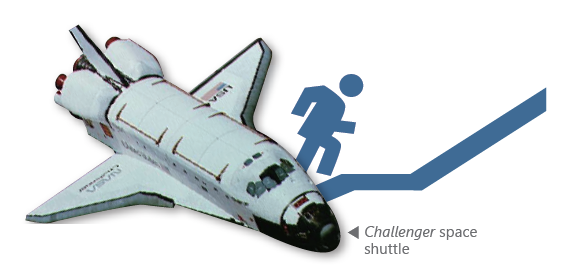
On January 28, 1986, thousands of people watched the launch of the Challenger space shuttle on television. Many were students in classrooms, like I was. Challenger stood on the launch pad. Rocket boosters underneath it lit up, and Challenger shot up into the blue sky. We students watched. Then, just over a minute after takeoff, Challenger broke apart. Streams of smoke spilled from it, and the shuttle fell in pieces into the ocean. People experienced a tragedy that day, and at NASA (the National Aeronautics and Space Administration), experts wanted to learn what went wrong. Challenger had minor problems from the start, but the disaster was caused by something called an O-ring. The O-ring was supposed to protect Challenger from the hot gas of a rocket booster. But the cold weather on the morning of the launch stopped the O-ring from working. Gases and flames burned through one fuel tank as the shuttle lifted off. Strong winds helped the flames. A fuel tank and a rocket booster collided. The fuel exploded and tore Challenger apart. Bad mechanics and bad weather both contributed, but humans could have stopped this disaster. NASA investigators learned that engineers knew the O-ring was flawed. It should have been redesigned, but its flaws weren't reported. Instead, the flaws were accepted. Investigators found that engineers only told the O-ring designer about its problems, not their NASA managers. This was against the rules, but the safety culture at NASA discouraged talking about problems. The Challenger disaster teaches us to speak up. Problems must be faced, not avoided, even if talking about them is npopular. When people are afraid to say anything but "yes," terrible accidents can happen. NASA's new regulations are designed to prevent that. Let's hope we've learned our lesson from Challenger.
1986年1月28日,數以千計的人在電視機前看著挑戰者號太空梭升空。許多人都和我一樣,當時只是學生。 挑戰者號停在發射臺上,下方的火箭推進器被點燃,接著太空梭便衝向藍天,我們這些學生盯著螢幕看。但在升空後一分鐘,挑戰者號卻突然解體。大量濃煙從機體竄出,機體的碎片也隨即落入大海。 人們在那天經歷了一樁悲劇,NASA(美國國家航空暨太空總署)的專家們也想知道,到底是哪裡出了錯。 挑戰者號一開始就有一些小問題,但造成這樁悲劇的是一個叫做O型環的東西。O型環原本是用來保護挑戰者號不受火箭推進器的熱氣所傷害,但是發射當天早上寒冷的天氣使得O型環失去作用。熱氣和火焰在太空梭升空時燒穿了燃料槽,強烈的風勢使火勢加劇。燃料槽和火箭推進器互相碰撞,導致燃料槽爆炸,也將挑戰者號炸成了碎片。 雖說是不良的機械設計和惡劣的天氣造成的不幸,但人為原本可以阻止慘劇發生的。NASA調查員發現工程師早就知道O型環有缺陷,應該要重新設計,但是這項缺陷不但沒有被呈報上去,還被接受了。調查員發現工程師只向O型環的設計師報告這個問題,而沒有向他們NASA的主管報告,這是違反規定的,但是NASA向來的安全文化使得大家都避談問題。 挑戰者號的悲劇教我們要勇於說出事實。遇到問題必須去面對而不是逃避,儘管大家都不喜歡討論問題,但當大家除了「沒問題」以外不願去說其他事情的時候,就可能發生可怕的意外。NASA後來就定了新規定,以免這種狀況再發生。希望我們已經從挑戰者號的意外中學到了教訓。 |